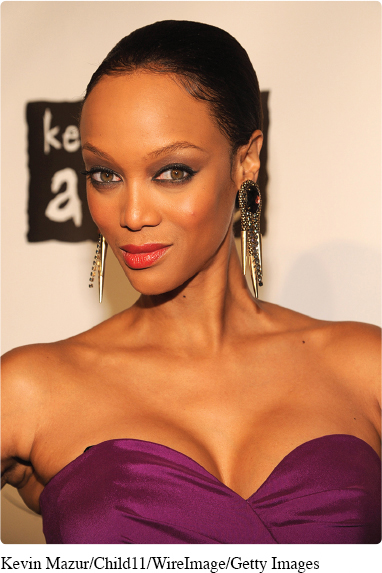6.3 Types of Nonverbal Communication
Your use of body movement, voice, touch, personal space, appearance, and environmental features work together to create your nonverbal communication. This influences how others perceive your messages, who you are, and how you feel. Understanding the different types of nonverbal expression and how they work will help you make sure these impressions are the right ones.
At age 16, Tyra Banks began doing fashion shows in Europe for designers such as Chanel, Valentino, and Fendi. She subsequently appeared in Elle and Vogue, and was the first African American woman to grace the cover of GQ. But what catapulted her to the top of the global modeling industry was not just her beauty—it was also her unique self-awareness of, and control over, the various types of nonverbal communication. For example, Tyra distinguishes 275 different smiles she uses when modeling that reflect specific emotions or situations, from anger to surprise. On her 22-season television show, America’s Next Top Model, Tyra taught seven basic smiles to her protégés that use different types of nonverbal communication.2 One of these smiles uses body posture and movement—specifically, shifting her shoulder position sideways and downward, and turning her head toward the listener. Another smile, which Tyra has famously coined the smize, doesn’t involve the mouth at all, just the eyes. The smize has been one of the most difficult and elusive expressions for aspiring models to emulate and has inspired videos and online tutorials on how to do it correctly.
2 T Screen Test Films: Tyra Banks (2008).
Tyra Banks has built a media empire from her uncanny ability to manipulate her nonverbal communication to create unique expressions on fashion runways, on television, and in photographs. But the types of nonverbal communication she uses—and coaches other models how to modify—are the very same ones you use in your daily life. Scholars of communication identify six such types: body movement, voice, touch, personal space, appearance, and environmental features. Although you experience these collectively as a whole, understanding how each type influences your own and others’ communication can make the difference between successful and unsuccessful interactions.
Tyra Banks believes that just a simple manipulation of your eyes and smile can cause a drastic change in the attitude you portray to the world. How do you use nonverbal communication to express your emotions?

Kevin Mazur/Child11/WireImage/Getty Images
